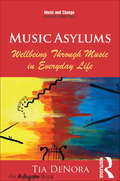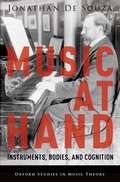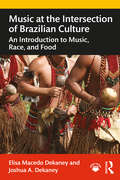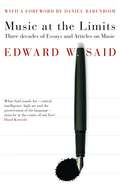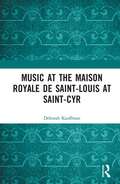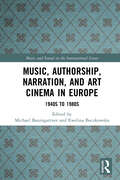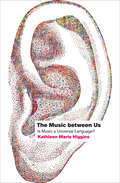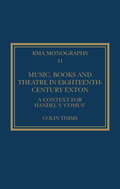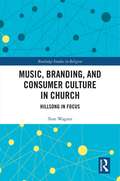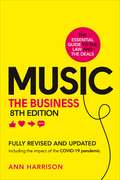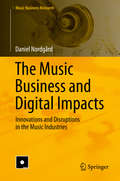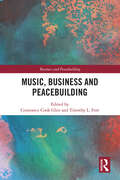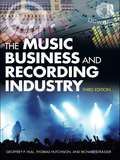- Table View
- List View
Music Asylums: Wellbeing Through Music in Everyday Life (Music and Change: Ecological Perspectives)
by Tia DeNoraTaking a cue from Erving Goffman’s classic work, Asylums, Tia DeNora develops a novel interdisciplinary framework for music, health and wellbeing. Considering health and illness both in medical contexts and in the often-overlooked realm of everyday life, DeNora argues that these identities are by no means mutually exclusive. Moreover, she suggests that the promotion of health and more specifically, mental health, involves a great deal more than a concern with medication, genetic predispositions, clinical and neuro-scientific procedures. Adopting a holistic, interactionist focus, Music Asylums reconnects states of wellness and wellbeing to encounters with others and - critically - to opportunities for aesthetic experience. Building on DeNora's earlier work on music as a technology of self in everyday life, the book presents music as an active ingredient of action, identity, capacity and consciousness. From there, it suggests that access to, and evaluation of, music is an important ethical matter. Intended for scholars and practitioners in psychiatry and psychology, palliative care, socio-music studies, music psychology and the allied health professions, Music Asylums showcases music's role in the existential project of being and staying well, mentally and physically, from moment-to-moment and across all realms of social life.
Music at Hand: Instruments, Bodies, and Cognition (Oxford Studies in Music Theory)
by Jonathan De SouzaFrom prehistoric bone flutes to pipe organs to digital synthesizers, instruments have been important to musical cultures around the world. Yet, how do instruments affect musical organization? And how might they influence players' bodies and minds? Music at Hand explores these questions with a distinctive blend of music theory, psychology, and philosophy. Practicing an instrument, of course, builds bodily habits and skills. But it also develops connections between auditory and motor regions in a player's brain. These multi-sensory links are grounded in particular instrumental interfaces. They reflect the ways that an instrument converts action into sound, and the ways that it coordinates physical and tonal space. Ultimately, these connections can shape listening, improvisation, or composition. This means that pianos, guitars, horns, and bells are not simply tools for making notes. Such technologies, as creative prostheses, also open up possibilities for musical action, perception, and cognition. Throughout the book, author Jonathan De Souza examines diverse musical case studies-from Beethoven to blues harmonica, from Bach to electronic music-introducing novel methods for the analysis of body-instrument interaction. A companion website supports these analytical discussions with audiovisual examples, including motion-capture videos and performances by the author. Written in lucid prose, Music at Hand offers substantive insights for music scholars, while remaining accessible to non-specialist readers. This wide-ranging book will engage music theorists and historians, ethnomusicologists, organologists, composers, and performers-but also psychologists, philosophers, media theorists, and anyone who is curious about how musical experience is embodied and conditioned by technology.
Music at Hand: Instruments, Bodies, and Cognition (Oxford Studies in Music Theory)
by Jonathan De SouzaFrom prehistoric bone flutes to pipe organs to digital synthesizers, instruments have been important to musical cultures around the world. Yet, how do instruments affect musical organization? And how might they influence players' bodies and minds? Music at Hand explores these questions with a distinctive blend of music theory, psychology, and philosophy. Practicing an instrument, of course, builds bodily habits and skills. But it also develops connections between auditory and motor regions in a player's brain. These multi-sensory links are grounded in particular instrumental interfaces. They reflect the ways that an instrument converts action into sound, and the ways that it coordinates physical and tonal space. Ultimately, these connections can shape listening, improvisation, or composition. This means that pianos, guitars, horns, and bells are not simply tools for making notes. Such technologies, as creative prostheses, also open up possibilities for musical action, perception, and cognition. Throughout the book, author Jonathan De Souza examines diverse musical case studies-from Beethoven to blues harmonica, from Bach to electronic music-introducing novel methods for the analysis of body-instrument interaction. A companion website supports these analytical discussions with audiovisual examples, including motion-capture videos and performances by the author. Written in lucid prose, Music at Hand offers substantive insights for music scholars, while remaining accessible to non-specialist readers. This wide-ranging book will engage music theorists and historians, ethnomusicologists, organologists, composers, and performers-but also psychologists, philosophers, media theorists, and anyone who is curious about how musical experience is embodied and conditioned by technology.
Music at the Intersection of Brazilian Culture: An Introduction to Music, Race, and Food
by Elisa Macedo Dekaney Joshua A. DekaneyMusic at the Intersection of Brazilian Culture takes an interdisciplinary approach by utilizing several aspects of Brazilian music, race, and food as a window to understanding Brazilian culture, with music at the core. Through a holistic understanding of the Brazilian experience – exploring issues of race, colonization, sustainable development, and the contributions of the three distinct ethnic groups in the making of Brazil – the authors create a narrative based on their own recollection of memories, traditions, customs, sounds, and landscapes that they experienced in Brazil. Each engaging section begins with an overview of the topic that places it in historical context, and then focuses on each subtopic with a thorough presentation of the content as well as suggested activities that can be implemented in the classroom. The chapters conclude with a list of useful references, resources, and audio recording examples, which are available on Spotify, to present readers with a musical landscape of the folktales. These can be found online via the Routledge catalogue page for this book. This book is an essential resource for students and teachers of music and cultural studies, as it unpicks complex issues to help readers better understand and appreciate Brazilian culture.
Music at the Intersection of Brazilian Culture: An Introduction to Music, Race, and Food
by Elisa Macedo Dekaney Joshua A. DekaneyMusic at the Intersection of Brazilian Culture takes an interdisciplinary approach by utilizing several aspects of Brazilian music, race, and food as a window to understanding Brazilian culture, with music at the core. Through a holistic understanding of the Brazilian experience – exploring issues of race, colonization, sustainable development, and the contributions of the three distinct ethnic groups in the making of Brazil – the authors create a narrative based on their own recollection of memories, traditions, customs, sounds, and landscapes that they experienced in Brazil. Each engaging section begins with an overview of the topic that places it in historical context, and then focuses on each subtopic with a thorough presentation of the content as well as suggested activities that can be implemented in the classroom. The chapters conclude with a list of useful references, resources, and audio recording examples, which are available on Spotify, to present readers with a musical landscape of the folktales. These can be found online via the Routledge catalogue page for this book. This book is an essential resource for students and teachers of music and cultural studies, as it unpicks complex issues to help readers better understand and appreciate Brazilian culture.
Music at the Limits: Three Decades Of Essays And Articles On Music
by Edward SaidMusic at the Limits brings together three decades of Edward W. Said's essays on music. Addressing the work of a wide variety of composers and performers, Said analyses music's social and political contexts, and provides rich and often surprising assessments. He reflects on the censorship of Wagner in Israel; the relationship between music and feminism; and the works of Beethoven, Bruckner, Rossini, Schumann, Stravinsky and others. Always eloquent and often surprising, Music at the Limits reinforces Said's reputation as one of the most influential writers of the twentieth century.
Music at the Maison royale de Saint-Louis at Saint-Cyr
by Deborah KauffmanThe history of music at the Maison royale de Saint-Louis at Saint-Cyr — the famous convent school founded by Madame de Maintenon and established by Louis XIV in 1686 as a royal foundation — is both rich and intriguing; its large repertory of music was composed expressly for young female voices by important composers working within significant contemporary musical genres: liturgical chant, sacred motets, theatrical music, and cantiques spirituels. While these genres reflect contemporary styles and trends, at the same time the works themselves were made to conform to the sensibilities and abilities of their intended performers. Even as Jean-Baptiste Moreau's music for Jean Racine’s biblical tragedies Esther and Athalie shows a number of similarities to contemporary tragédies lyriques, it departs from that more public genre in its brevity, generally simpler solo writing, and the integral use of the chorus. The musical style of the choral numbers closely parallels that of other choral music in the repertory at Saint-Cyr. The liturgical chant sung in the church was composed by Guillaume-Gabriel Nivers, and is an example of plain-chant musical, a type of new ecclesiastical composition written during the seventeenth and eighteenth centuries, primarily for female religious communities in France. The large repertory of petits motets (short sacred Latin pieces for solo voice), mostly composed by Nivers and Louis-Nicolas Clérambault, are simpler and more restrained than works by their contemporaries. A close study of the motets reveals much about changes to musical style and performance practices at Saint-Cyr during the eighteenth century. The cantique spirituel, a song with a spiritual text in the vernacular French language, played a significant role in both the education and recreation of the girls at Saint-Cyr. Cantiques composed for the girls vary widely in terms of their style and difficulty, ranging from simple strophic melodies to more sophisticated works in the style of contemporary airs. In all cases, the stylistic features of the music for Saint-Cyr reflect a careful consideration of the needs and capabilities of the young singers of the school, as well as an awareness of the rigorous requirements of Madame de Maintenon, who kept a close watch over the propriety of all things relating to the piety, behavior, and image of her charges.
Music at the Maison royale de Saint-Louis at Saint-Cyr
by Deborah KauffmanThe history of music at the Maison royale de Saint-Louis at Saint-Cyr — the famous convent school founded by Madame de Maintenon and established by Louis XIV in 1686 as a royal foundation — is both rich and intriguing; its large repertory of music was composed expressly for young female voices by important composers working within significant contemporary musical genres: liturgical chant, sacred motets, theatrical music, and cantiques spirituels. While these genres reflect contemporary styles and trends, at the same time the works themselves were made to conform to the sensibilities and abilities of their intended performers. Even as Jean-Baptiste Moreau's music for Jean Racine’s biblical tragedies Esther and Athalie shows a number of similarities to contemporary tragédies lyriques, it departs from that more public genre in its brevity, generally simpler solo writing, and the integral use of the chorus. The musical style of the choral numbers closely parallels that of other choral music in the repertory at Saint-Cyr. The liturgical chant sung in the church was composed by Guillaume-Gabriel Nivers, and is an example of plain-chant musical, a type of new ecclesiastical composition written during the seventeenth and eighteenth centuries, primarily for female religious communities in France. The large repertory of petits motets (short sacred Latin pieces for solo voice), mostly composed by Nivers and Louis-Nicolas Clérambault, are simpler and more restrained than works by their contemporaries. A close study of the motets reveals much about changes to musical style and performance practices at Saint-Cyr during the eighteenth century. The cantique spirituel, a song with a spiritual text in the vernacular French language, played a significant role in both the education and recreation of the girls at Saint-Cyr. Cantiques composed for the girls vary widely in terms of their style and difficulty, ranging from simple strophic melodies to more sophisticated works in the style of contemporary airs. In all cases, the stylistic features of the music for Saint-Cyr reflect a careful consideration of the needs and capabilities of the young singers of the school, as well as an awareness of the rigorous requirements of Madame de Maintenon, who kept a close watch over the propriety of all things relating to the piety, behavior, and image of her charges.
Music, Authorship, Narration, and Art Cinema in Europe: 1940s to 1980s (Music and Sound on the International Screen)
by Michael Baumgartner Ewelina BoczkowskaMusic, Authorship, Narration, and Art Cinema in Europe: 1940s to 1980s investigates the function of music in European cinema after the Second World War up to the fall of the Berlin wall, a period when composers and directors embraced experimentation. Through analyses of music and sound in a wide range of iconic films from across Europe, the essays in this book provide a nuanced reconsideration of three core themes: auteur theory, art house film, and national cinema. Chapters written by an international array of contributors focus on case studies of music in the cinema of Carlos Saura, Jean-Pierre Melville, the Polish School, and Romanian directors, as well as collaborations between directors and composers, including Michelangelo Antonioni and Giovanni Fusco, Federico Fellini and Nino Rota, Leo Arnshtam and Dmitry Shostakovich, and Peter Greenaway and Michael Nyman. The contributors shift the emphasis from a director-centered view to the working relationship between director and composer, and from the visual component to the sonic aspects of these films, without ignoring the close correlation between soundtrack and visual elements. Enriching our understanding of the complex, intertwined nature of authorship in film, the role of film music, and sound, nation-state and art cinema, and European cinematic history, this volume offers a valuable addition to research across music and film studies.
Music, Authorship, Narration, and Art Cinema in Europe: 1940s to 1980s (Music and Sound on the International Screen)
by Michael Baumgartner Ewelina BoczkowskaMusic, Authorship, Narration, and Art Cinema in Europe: 1940s to 1980s investigates the function of music in European cinema after the Second World War up to the fall of the Berlin wall, a period when composers and directors embraced experimentation. Through analyses of music and sound in a wide range of iconic films from across Europe, the essays in this book provide a nuanced reconsideration of three core themes: auteur theory, art house film, and national cinema. Chapters written by an international array of contributors focus on case studies of music in the cinema of Carlos Saura, Jean-Pierre Melville, the Polish School, and Romanian directors, as well as collaborations between directors and composers, including Michelangelo Antonioni and Giovanni Fusco, Federico Fellini and Nino Rota, Leo Arnshtam and Dmitry Shostakovich, and Peter Greenaway and Michael Nyman. The contributors shift the emphasis from a director-centered view to the working relationship between director and composer, and from the visual component to the sonic aspects of these films, without ignoring the close correlation between soundtrack and visual elements. Enriching our understanding of the complex, intertwined nature of authorship in film, the role of film music, and sound, nation-state and art cinema, and European cinematic history, this volume offers a valuable addition to research across music and film studies.
The Music between Us: Is Music a Universal Language?
by Kathleen Marie HigginsFrom our first social bonding as infants to the funeral rites that mark our passing, music plays an important role in our lives, bringing us closer to one another. In The Music between Us, philosopher Kathleen Marie Higgins investigates this role, examining the features of human perception that enable music’s uncanny ability to provoke, despite its myriad forms across continents and throughout centuries, the sense of a shared human experience. Drawing on disciplines such as philosophy, psychology, musicology, linguistics, and anthropology, Higgins’s richly researched study showcases the ways music is used in rituals, education, work, healing, and as a source of security and—perhaps most importantly—joy. By participating so integrally in such meaningful facets of society, Higgins argues, music situates itself as one of the most fundamental bridges between people, a truly cross-cultural form of communication that can create solidarity across political divides. Moving beyond the well-worn takes on music’s universality, The Music between Us provides a new understanding of what it means to be musical and, in turn, human.
The Music between Us: Is Music a Universal Language?
by Kathleen Marie HigginsFrom our first social bonding as infants to the funeral rites that mark our passing, music plays an important role in our lives, bringing us closer to one another. In The Music between Us, philosopher Kathleen Marie Higgins investigates this role, examining the features of human perception that enable music’s uncanny ability to provoke, despite its myriad forms across continents and throughout centuries, the sense of a shared human experience. Drawing on disciplines such as philosophy, psychology, musicology, linguistics, and anthropology, Higgins’s richly researched study showcases the ways music is used in rituals, education, work, healing, and as a source of security and—perhaps most importantly—joy. By participating so integrally in such meaningful facets of society, Higgins argues, music situates itself as one of the most fundamental bridges between people, a truly cross-cultural form of communication that can create solidarity across political divides. Moving beyond the well-worn takes on music’s universality, The Music between Us provides a new understanding of what it means to be musical and, in turn, human.
The Music between Us: Is Music a Universal Language?
by Kathleen Marie HigginsFrom our first social bonding as infants to the funeral rites that mark our passing, music plays an important role in our lives, bringing us closer to one another. In The Music between Us, philosopher Kathleen Marie Higgins investigates this role, examining the features of human perception that enable music’s uncanny ability to provoke, despite its myriad forms across continents and throughout centuries, the sense of a shared human experience. Drawing on disciplines such as philosophy, psychology, musicology, linguistics, and anthropology, Higgins’s richly researched study showcases the ways music is used in rituals, education, work, healing, and as a source of security and—perhaps most importantly—joy. By participating so integrally in such meaningful facets of society, Higgins argues, music situates itself as one of the most fundamental bridges between people, a truly cross-cultural form of communication that can create solidarity across political divides. Moving beyond the well-worn takes on music’s universality, The Music between Us provides a new understanding of what it means to be musical and, in turn, human.
The Music between Us: Is Music a Universal Language?
by Kathleen Marie HigginsFrom our first social bonding as infants to the funeral rites that mark our passing, music plays an important role in our lives, bringing us closer to one another. In The Music between Us, philosopher Kathleen Marie Higgins investigates this role, examining the features of human perception that enable music’s uncanny ability to provoke, despite its myriad forms across continents and throughout centuries, the sense of a shared human experience. Drawing on disciplines such as philosophy, psychology, musicology, linguistics, and anthropology, Higgins’s richly researched study showcases the ways music is used in rituals, education, work, healing, and as a source of security and—perhaps most importantly—joy. By participating so integrally in such meaningful facets of society, Higgins argues, music situates itself as one of the most fundamental bridges between people, a truly cross-cultural form of communication that can create solidarity across political divides. Moving beyond the well-worn takes on music’s universality, The Music between Us provides a new understanding of what it means to be musical and, in turn, human.
The Music between Us: Is Music a Universal Language?
by Kathleen Marie HigginsFrom our first social bonding as infants to the funeral rites that mark our passing, music plays an important role in our lives, bringing us closer to one another. In The Music between Us, philosopher Kathleen Marie Higgins investigates this role, examining the features of human perception that enable music’s uncanny ability to provoke, despite its myriad forms across continents and throughout centuries, the sense of a shared human experience. Drawing on disciplines such as philosophy, psychology, musicology, linguistics, and anthropology, Higgins’s richly researched study showcases the ways music is used in rituals, education, work, healing, and as a source of security and—perhaps most importantly—joy. By participating so integrally in such meaningful facets of society, Higgins argues, music situates itself as one of the most fundamental bridges between people, a truly cross-cultural form of communication that can create solidarity across political divides. Moving beyond the well-worn takes on music’s universality, The Music between Us provides a new understanding of what it means to be musical and, in turn, human.
The Music between Us: Is Music a Universal Language?
by Kathleen Marie HigginsFrom our first social bonding as infants to the funeral rites that mark our passing, music plays an important role in our lives, bringing us closer to one another. In The Music between Us, philosopher Kathleen Marie Higgins investigates this role, examining the features of human perception that enable music’s uncanny ability to provoke, despite its myriad forms across continents and throughout centuries, the sense of a shared human experience. Drawing on disciplines such as philosophy, psychology, musicology, linguistics, and anthropology, Higgins’s richly researched study showcases the ways music is used in rituals, education, work, healing, and as a source of security and—perhaps most importantly—joy. By participating so integrally in such meaningful facets of society, Higgins argues, music situates itself as one of the most fundamental bridges between people, a truly cross-cultural form of communication that can create solidarity across political divides. Moving beyond the well-worn takes on music’s universality, The Music between Us provides a new understanding of what it means to be musical and, in turn, human.
Music, Books and Theatre in Eighteenth-Century Exton: A Context for Handel's ‘Comus’ (Royal Musical Association Monographs)
by Colin TimmsThis book establishes the cultural background to the productions of Milton’s Comus that were staged in the 1740s by Baptist Noel, 4th Earl of Gainsborough, at Exton Hall, his country seat in the East Midlands of England. The author reveals that Handel’s visit in 1745 occurred in a richer and fuller context of cultural interests among the Noel family. Most of the music at Exton was selected from existing works by Handel, but the four movements of the finale were new, written by the composer specifically for the occasion. The study is based on receipted bills and other documents in an archival collection of Noel family papers that provide evidence of the Earl’s purchase of books and music and of the musical and theatrical activities undertaken on his Exton estate. The author discusses the Earl’s interests in music, books and theatre, indicating a belief in performance as a valuable and enjoyable experience and as a vehicle for the education of the young. In addition to creating a context for Comus, this book sheds light on cultural life in a mid-eighteenth-century English country house and how the Earl’s productions made a significant contribution to the cultural life of the East Midlands. The book will be of great value to cultural musicologists, historians and Handelians, as the documentation sheds a huge amount of light on a variety of cultural practices in eighteenth-century England.
Music, Books and Theatre in Eighteenth-Century Exton: A Context for Handel's ‘Comus’ (Royal Musical Association Monographs)
by Colin TimmsThis book establishes the cultural background to the productions of Milton’s Comus that were staged in the 1740s by Baptist Noel, 4th Earl of Gainsborough, at Exton Hall, his country seat in the East Midlands of England. The author reveals that Handel’s visit in 1745 occurred in a richer and fuller context of cultural interests among the Noel family. Most of the music at Exton was selected from existing works by Handel, but the four movements of the finale were new, written by the composer specifically for the occasion. The study is based on receipted bills and other documents in an archival collection of Noel family papers that provide evidence of the Earl’s purchase of books and music and of the musical and theatrical activities undertaken on his Exton estate. The author discusses the Earl’s interests in music, books and theatre, indicating a belief in performance as a valuable and enjoyable experience and as a vehicle for the education of the young. In addition to creating a context for Comus, this book sheds light on cultural life in a mid-eighteenth-century English country house and how the Earl’s productions made a significant contribution to the cultural life of the East Midlands. The book will be of great value to cultural musicologists, historians and Handelians, as the documentation sheds a huge amount of light on a variety of cultural practices in eighteenth-century England.
Music, Branding and Consumer Culture in Church: Hillsong in Focus (Routledge Studies in Religion)
by Tom WagnerStarting as a single congregation in Australia, Hillsong Church now has campuses worldwide, releases worship music that sells millions of albums and its ministers regularly appear in mainstream media. So, how has a single church gained such international prominence? This book offers an ethnographic exploration of the ways in which music and marketing have been utilised in the pursuit and production of spiritual experience for members of Hillsong Church. An experience that has proven to be incredibly popular. The main theme of this book is that marketing, specifically branding, is not just a way to "sell" religion, but rather an integral part of spiritual experience in consumer society. Focussing on the London Hillsong church as a case study, the use of its own music in tandem with strong branding is shown to be a co- and re-productive method of organizing, patterning, and communicating information. The church provides the branded material and cultural context in which participants’ sacred experience of self unfolds. However, this requires participants to "do the work" to properly understand, and ultimately embody, the values associated with the brand. This book raises important questions about the role of branding and music in forming modern scared identities. As such, it will be of great interest to scholars of Religious Studies, Ethnomusicology and Media Studies.
Music, Branding and Consumer Culture in Church: Hillsong in Focus (Routledge Studies in Religion)
by Tom WagnerStarting as a single congregation in Australia, Hillsong Church now has campuses worldwide, releases worship music that sells millions of albums and its ministers regularly appear in mainstream media. So, how has a single church gained such international prominence? This book offers an ethnographic exploration of the ways in which music and marketing have been utilised in the pursuit and production of spiritual experience for members of Hillsong Church. An experience that has proven to be incredibly popular. The main theme of this book is that marketing, specifically branding, is not just a way to "sell" religion, but rather an integral part of spiritual experience in consumer society. Focussing on the London Hillsong church as a case study, the use of its own music in tandem with strong branding is shown to be a co- and re-productive method of organizing, patterning, and communicating information. The church provides the branded material and cultural context in which participants’ sacred experience of self unfolds. However, this requires participants to "do the work" to properly understand, and ultimately embody, the values associated with the brand. This book raises important questions about the role of branding and music in forming modern scared identities. As such, it will be of great interest to scholars of Religious Studies, Ethnomusicology and Media Studies.
Music: The Business (8th edition)
by Ann HarrisonThis essential and highly acclaimed guide, now updated and revised in its eighth edition, explains the business of the British music industry.Drawing on her extensive experience as a media lawyer, Ann Harrison offers a unique, expert opinion on the deals, the contracts and the business as a whole. She examines in detail the changing face of the music industry and provides absorbing and up-to-date case studies.Whether you're a recording artist, songwriter, music business manager, industry executive, publisher, journalist, media student, accountant or lawyer, this practical and comprehensive guide is indispensable reading.Fully revised and updated. Includes:· The current types of record and publishing deals, and what you can expect to see in the contracts· A guide to making a record, manufacture, distribution, branding, marketing, merchandising, sponsorship, band arrangements and touring· Information on music streaming, digital downloads and piracy· The most up-to-date insights on how the COVID-19 crisis has affected marketing· An in-depth look at copyright law and related rights· Case studies illustrating key developments and legal jargon explained.
The Music Business and Digital Impacts: Innovations and Disruptions in the Music Industries (Music Business Research)
by Daniel NordgårdThis book provides rare insights into the difficult and complex dialogues between stakeholders within and outside the music industries in a time of transition. It builds on a series of recorded meetings in which key stakeholders discuss and assess options and considerations for the music industries’ transition to a digital era. These talks were closed to the public and operated under the Chatham House Rule, which means that they involved a very different type of discussion from those held in public settings, panels or conferences. As such, the book offers a much more nuanced understanding of the industries’ difficulties in adjusting to changing conditions, demonstrating the internal power-struggles and differences that make digital change so difficult. After presenting a theoretical framework for assessing digital change in the music industries, the author then provides his research findings, including quotes from the Kristiansand Roundtable Conference. Following from these findings, he develops three critical concepts that explain the nature as well as the problems of the music industries’ adaptation process. In conclusion, he challenges the general definition of crisis in the music industries and contradicts the widely held view that digitalization is a case of vertical integration.
Music, Business and Peacebuilding (Business and Peacebuilding)
by Timothy L. Fort Constance Cook GlenBusiness schools are placing more emphasis on the role of business in society. Top business school accreditors are shifting to mandating that schools teach their students about the social impact of business, including AACSB standards to require the incorporation of business impact on society into all elements of accredited institutions. Researchers are also increasingly focused on issues related to sustainability, but in particular to business and peace as a field. A strong strain of scholarship argues that ethics is nurtured by emotions and through aesthetic quests for moral excellence. The arts (and music as shown specifically in this book) can be a resource to nudge positive emotions in the direction toward ethical behavior and, logically, then toward peace. Business provides a model for positive interactions that not only foster long-term successful business but also incrementally influences society. This book provides an opportunity for integration and recognition of how music (and other art forms) can further encourage business toward the direction of peace while business provides a platform for the dissemination and modeling of the positive capabilities of music toward the aims of peace in the world today. The primary market for this book is the academic audience. Unlike many other academic books, however, the interdisciplinary nature of the book allows for multiple academic audiences. Thus, this book reaches into schools of music, business, political science, film studies, sports and society studies, the humanities, ethics and, of course, peace studies.
Music, Business and Peacebuilding (Business and Peacebuilding)
by Timothy L. Fort Constance Cook GlenBusiness schools are placing more emphasis on the role of business in society. Top business school accreditors are shifting to mandating that schools teach their students about the social impact of business, including AACSB standards to require the incorporation of business impact on society into all elements of accredited institutions. Researchers are also increasingly focused on issues related to sustainability, but in particular to business and peace as a field. A strong strain of scholarship argues that ethics is nurtured by emotions and through aesthetic quests for moral excellence. The arts (and music as shown specifically in this book) can be a resource to nudge positive emotions in the direction toward ethical behavior and, logically, then toward peace. Business provides a model for positive interactions that not only foster long-term successful business but also incrementally influences society. This book provides an opportunity for integration and recognition of how music (and other art forms) can further encourage business toward the direction of peace while business provides a platform for the dissemination and modeling of the positive capabilities of music toward the aims of peace in the world today. The primary market for this book is the academic audience. Unlike many other academic books, however, the interdisciplinary nature of the book allows for multiple academic audiences. Thus, this book reaches into schools of music, business, political science, film studies, sports and society studies, the humanities, ethics and, of course, peace studies.
The Music Business and Recording Industry
by Geoffrey P Hull Thomas Hutchison Richard StrasserThe Music Business and Recording Industry is a comprehensive music business textbook focused on the three income streams in the music industry: music publishing, live entertainment, and recordings. The book provides a sound foundation for understanding key issues, while presenting the latest research in the field. It covers the changes in the industry brought about by the digital age, such as changing methods of distributing and accessing music and new approaches in marketing with the Internet and mobile applications. New developments in copyright law are also examined, along with the global and regional differences in the music business.
